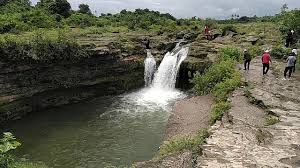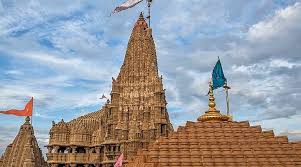Trekking to Jamjir Waterfalls in Gir

Introduction
Nestled in the western state of Gujarat, the Jamjir Waterfalls, also known as Zanzari Waterfalls, remain one of the lesser-explored natural wonders near the Gir forest region. Often overshadowed by the famed Asiatic lions of Gir National Park, this cascading beauty offers a different kind of thrill — a peaceful escape for trekkers, nature lovers, and photographers. Surrounded by lush forest cover, Jamjir Waterfalls provide the perfect blend of adventure and serenity, making it a must-visit for anyone seeking a raw and authentic outdoor experience in Gujarat.
Location and Accessibility
Jamjir Waterfalls are located near Jamvala village in the Gir Somnath district of Gujarat. The falls lie about 30 kilometers from Sasan Gir, making it a convenient detour for travelers visiting the national park. The nearest railway station is Veraval, while Keshod Airport serves as the closest airport for domestic flights.
From Sasan Gir or Veraval, local transport options such as jeeps, private taxis, and bikes are available to reach Jamvala village. The road journey is scenic, winding through farmlands and forest edges, building anticipation for the trek ahead.
The Trekking Experience
The trail to Jamjir Waterfalls is moderately easy, suitable for beginners and seasoned trekkers alike. The trek starts from Jamvala village, and depending on the season, it may take 30 to 60 minutes to reach the main falls. During monsoons, the trail becomes slippery and more challenging, adding a layer of adventure.
As you move through narrow forest paths, you’ll encounter the rich biodiversity of the region — from chirping birds and butterflies to occasional peacocks or deer. The sound of cascading water grows louder with each step, drawing you toward the hidden gem that awaits.
Natural Beauty and Surroundings
Jamjir Waterfalls are not exceptionally tall, but their wide and multi-layered cascade creates a stunning visual. The water plunges into a natural rocky pool, perfect for a quick dip or relaxation. Surrounded by rugged rock formations and tropical vegetation, the site feels untouched and pristine.
The area around the falls is ideal for picnics and photography. Early morning and late afternoon offer the best light for capturing the falls in all their glory. If you’re lucky, you might even catch a rainbow forming across the misty spray.
Best Time to Visit
The best time to visit Jamjir Waterfalls is during the monsoon and post-monsoon months, from July to October. During this period, the falls are in full flow, and the surrounding landscape is lush and green. Winter months (November to February) are also pleasant and suitable for trekking, though the water volume may be lower.
It is advisable to avoid the peak summer months (March to June) due to high temperatures and low water levels, which diminish the waterfall’s beauty.
Tips for Trekkers and Visitors
- Wear sturdy trekking shoes: The terrain can get slippery, especially during monsoons.
- Carry water and snacks: There are limited facilities near the waterfalls.
- Avoid plastics: Help maintain the area’s natural beauty by not littering.
- Travel in groups: While the trail is safe, group trekking ensures added safety and enjoyment.
- Respect local customs: Jamvala is a small village with traditional values, so dress modestly and interact respectfully.
Local Culture and Village Life
Jamvala village offers a glimpse into rural Gujarat’s lifestyle. Warm-hearted and hospitable, the locals often welcome travelers and may even guide them along the trek. Agriculture and animal husbandry are the primary occupations here. Spending time in the village can be a refreshing cultural exchange, especially for urban visitors.
Traditional snacks like thepla, fafda, and chai are often available in small shops, offering an authentic taste of Gujarat’s culinary simplicity.
Combining with Gir National Park
Many travelers combine a visit to Jamjir Waterfalls with a trip to Gir National Park, home to the world’s last remaining Asiatic lions. This makes for a diverse weekend itinerary — from wildlife safaris to peaceful nature treks.
Start your day with a morning safari in Gir, followed by an afternoon hike to the waterfalls. It’s a wholesome way to experience both the thrill of the wild and the tranquility of natural landscapes.
Conservation and Responsible Tourism
As Jamjir Waterfalls begin to attract more footfall, it’s vital to promote eco-friendly tourism practices. Visitors should refrain from damaging the natural habitat, avoid loud music, and take their trash back with them. Local authorities and travel organizations are encouraged to implement guidelines that preserve this natural treasure.
Creating awareness about such hidden destinations also opens avenues for community-based tourism, providing income to villagers while promoting conservation.
Future Potential and Tourism Development
Jamjir Waterfalls have immense potential to become a sustainable tourism hotspot. Infrastructure improvements like signboards, eco-toilets, and a designated trek route can make the experience smoother for visitors while preserving the ecology.
Collaboration between the Gujarat Tourism Department, local NGOs, and village communities can ensure that the area is promoted responsibly. Homestays, guided treks, and nature camps are possible initiatives that can boost tourism without harming the environment.
Conclusion
Trekking to Jamjir Waterfalls in Gir is not just about reaching a beautiful destination — it’s a journey through Gujarat’s unexplored landscapes, rural warmth, and vibrant biodiversity. For those seeking a break from tourist-heavy spots and craving an offbeat adventure, Jamjir delivers an experience that is both rejuvenating and memorable.
As more travelers seek meaningful connections with nature, places like Jamjir remind us of the need to explore responsibly, appreciate deeply, and leave only footprints behind.


